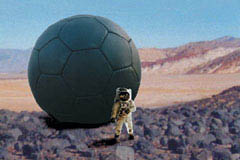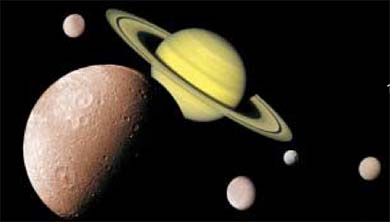천문학의 가장 큰 수수께끼의 하나는 잃어버린 질량의 신비다. 지난 1월 몇몇 천문학자들은 잃어버린 질량은 어느 정도 볼 수 있게 할 수도 있다고 안했다.
잃어버린 질량은 볼 수 없거나 확인될 수 없지만 천문학자들이 있다고 확신하는 우주 안의 물체에 속한다. 그들은 그것이 무엇인지 무엇일 수 있는지를 모른다. 그런데도 불구하고 그들은 그것이 존재함을 확신한다.
어떻게? 천문학자들은 많은 은하들을 연구해 왔다. 그들은 항성들과 그 안에서 볼 수 있는 빠른 밝은 물체들도 연구하고 있다. 자신들이 보는 것으로부터 그들은 은하의 질량(곧 물질의 총량)을 계산할 수 있다. 그들은 이 질량의 90퍼센트가 은하 중심부의 비교적 작은 지역에 집중된다고 말할 수 있다.
이로부터 그들은 한걸음 더 나아가서 은하가 어떻게 회전해야 하는가를 계산할 수 있다. 중심 가까이 있는 항성들은 빨리, 멀리 떨어진 항성들은 더 느리게 운동해야 한다 (우리 태양계에서 행성들의 운동도 이런 식이다) 다만 문제가 있다면 은하와 은하는 이렇게 돌지 않는다는 점이다. 더 먼 항성들이 더 가까운 것들만큼 빨리 움직인다. 우리가 이것을 설명할 수 있는 유일한 방법은 은하의 변두리에 우리가 확인할 수 없는가외의 질량이 있음을 가정하는 것이다.
그것이 무엇일까? 너무 작아서 빛나지는 못해도 각각 질량을 공급하는 작은 물체들의 구름이 겹겹이 쌓인 것인가? 우리가 결코 확인하지 못했고 아직 아무것도 모르는 원자를 구성하는 무서운 입자들의 거대한 배열인가? 알 수가 없다. 그러나 무엇인가 거기에 있다.
그것은 회전하는 은하들의 물질도 아니다. 은하들은 모든 크기의 성단들 안에 배열돼 있다. 어떤 성단들은 우리가 속한 성단이 그렇듯이 몇십개의 은하들을 포함하고 다른 성단들은 몇백 아니 몇천개의 은하들을 갖고 있다.
천문학자들이 성단들을 조사할 때는 개개의 은하들의 질량, 그리고 그들이 서로 가하는 중력적 당김의 힘을 측정할 수 있음을 발견한다. 그들은 또한 성단 안에서 개개의 은하들이 움직이는 속도도 측정할 수 있다. 그러나 모든 경우에 은하들이 서로 미치는 중력의 양은 그들이 움직이는 속도를 고려할 때 은하들이 뿔뿔이 흩어지지 못하게 할만큼 충분한 것 같지는 않다.
그들이 달라붙을 수 있는 유일한 길은 우리가 보는 물질에 의해 설명될 수 있는 것보다 더 많은 질량, 따라서 더 많은 중력적 당김이 있다고 가정하는 것이다. 성단이 크면 클수록 그 가외의 질량은 많아야 한다.
많은 천문학자들은 잃어버린 질량의 우주의 총 질량의 90퍼센트를 보충할지도 모른다고 느낀다. 이것 때문에 우리가 그것을 확인할 수 없고 그 본질을 모르는 것이 더욱 좌절감을 준다.
우리에게 그것이 어디에 있는가의 암시를 줄지도 모르는 질량이 할 수 있는 것이 있는가?
1916년에 이미 알버트 아인슈타인은 그의 일반상대성이론을 이용해 광선이 중력장의 영향을 받는 거대한 물체를 지나갈 때 구부러진다는 것을 예측했다. 구부러지는 양은 질량의 크기와 빛에 얼마나 가까운가에 달려 있을 것이며 아인슈타인은 그것이 모두 어떻게 작용할 것인가를 계산했다. 그의 예측은 1919년에 증명되었고 그 이후 여러가지 방법으로 여러 차례 입증되었다. 천문학자들은 모두 빛이 특별히 큰 물체 가까이 지날 때에는 눈에 띄게 구부러진다는 것을 확신하고 있다.
그러면 당신이 우리가 이해할 수 있을만큼 아주 먼 은하를 연구한다고 가정하자. 그 빛은 우리를 향해 몇 백만광년 이상 여행하며 그렇게 하는 과정에서 때때로 은하들의 두꺼운 성단을 통과할지도 모른다. 그 성단의 중력장은 먼 은하에서 오는 약한 빛에 작은 꼬임을 끌어들일 수 있다.
뉴저지주 머리힐에 있는 미국전화전신회사 벨연구소와 앤터니 타이슨이 이끄는 애리조나주 투산의 국립광학천문대의 천문학자들은 1990년 1월 18일 바로 그 일을 했다고 발표했다. 이것은 새롭고 발전된 "전하로 연결된 장치"와 결과를 분석하는 데 쓰이는 특별히 개발된 컴퓨터 프로그램을 사용함으로써 가능했다.
이 작은 꼬인 빛으로부터 그들은 은하들의 성단안에서 잃어버린 질량이 어디 있는가를 말할 수 있다고 생각한다. 아마도 이 기법을 써서 마침내 우주의 지도를 만들고 여기에 더, 저기에 덜하는 식으로 잃어버린 질량의 분포를 결정할 수 있을 것이다. 이것은 우리에게 그 질량의 본질에 관한 암시를 주는 데 성공할지 모르며 그것은 또한 우리가 아직 모르는 우주에 관해 많은 것을 설명할 수 있을지 모른다.
그러나 우리는 너무 열심히 앞으로 뛰어서는 안된다. 새 기법은 될 수 있는 것의 모서리에 있을 뿐이므로 다른 것들에 의해 검증되어야 할 것이다. 실제로 어떤 천문학자들은 이미 새 기법이 전적으로 믿을 수 있는지에 대해 회의를 표했다.
그런데도 불구하고 이 "잃어버린 질량의 신비"를 둘러싼 과학적 좌절이 크기 때문에 가능한 해결로 향한 가장 작은 발걸음에도 흥분할 수밖에 없다.
Tiny Twisty Light
One of the greatest puzzles in astronomy is the "mystery of the missing mass." In January, some astronomers reported that the missing mass may be made visible after a fashion.
The missing mass belongs to objects in the Universe that can't be seen or otherwise detected but that astronomers are certain is there. They don't know what it is or what it might be but they are nevertheless certain it is there.
How? Well, astronomers have studied a large number of galaxies. They have studied the stars and other bright objects that they can see within them. From what they see, they can calculate the mass (that is, the total amount of matter) of the galaxy. They can tell that 90 percent of this mass is concentrated in a comparatively small region at the center of the galaxy.
From this, they can further calculate just how the galaxy ought to rotate. The stars near the center should move quickly; the stars farther away more slowly (that's how the planets move in our solar system.) They only trouble is that galaxy after galaxy don't turn in this way. The more distant stars move as quickly as the closer ones. The only way we can explain this is to assume that there is additional mass in the outskirts of the galaxy, mass that we can't detect.
What can it be? Clouds upon clouds of small bodies, too small to shine, but each supplying mass? Vast arrays of massive subatomic particles we have never detected and know nothing about as yet? We don't know, but something is there.
Nor is it just a matter of turning galaxies. The galaxies are arranged in clusters of all sizes. Some contain dozens of galaxies, as the one we belong to does, while others contain hundreds or even thousands of galaxies. When astronomers examine the clusters, they find they can measure the mass of the individual galaxies, and therefore the strength of the gravitational pull they exert on each other. They can also measure the speed at which the individual galaxies move within the cluster. In every case, though, the amount of gravitation that the galaxies exert on each other does not seem to be sufficient to keep the galaxies from drifting apart considering the speed at which they are moving.
The only way in which they can cling together is to suppose there is more mass, and therefore more gravitational pull, than can be explained by the matter we see. The larger the cluster, the more that extra mass has to be.
A number of astronomers feel that the missing mass may make up 90 percent of the total mass of the Universe. This makes it all the more frustrating that we can't detect it and don't know the nature of it.
Is there anything the mass can do that might give us a hint of exactly where it is? In theory, there is.
As long age as 1916, Albert Einstein, making use of his General Theory of Relativity, predicted that rays of light would bend when they moved past massive objects that subjected them to a gravitational field. The amount of bending would depend on the amount of mass and its nearness to the light, and Einstein calculated just how it would all work. His prediction was verified in 1919, and many, many times since, in a large variety of ways. Astronomers are all convinced that light bends noticeably when it passes near a particularly massive body.
Suppose then, that you study a very distant galaxy, one that is just about as far away as we can make it out. Its light travels toward us over millions of light-years and, in doing so, may occasionally pass through a thick cluster of galaxies. The gravitational field of that cluster may introduce a tiny twist on that faint bit of light from the distant galaxy.
Astronomers at the American Telephone and Telegraph Bell Laboratories at Murray Hill, N. J. and the National Optical Astronomy Observatory in Tucson, Ariz., headed by J. Anthony Tyson, announced, on Jan. 18, 1990, that they have managed to do just that, by the use of new and advanced "charge-coupled devices" plus specially developed computer programs used to analyze the results.
From this tiny twisty light, they can tell, they think, just where, within the cluster of galaxies, the missing mass might be. Perhaps using this technique the Universe can eventually be mapped, so to speak, and the distribution of missing mass determined-more here, less there. This may succeed in giving us hints as to the nature of that mass, and that, in turn, might explain a great deal about the Universe that we do not yet know.
However, we must not jump too eagerly forward. The new technique is just at the edge of what can be done, and it will have to be checked by others. In fact, some astronomers have already expressed their doubts as to whether the new technique can be entirely trusted.
Nevertheless, such is the scientific frustration over this "mystery of the missing mass" that there is bound to be excitement over even the smallest step toward a possible solution.
이 기사의 내용이 궁금하신가요?
기사 전문을 보시려면500(500원)이 필요합니다.
1990년 04월 과학동아 정보
🎓️ 진로 추천
- 천문학
- 물리학
- 지구과학

















